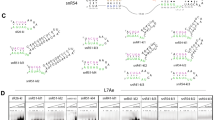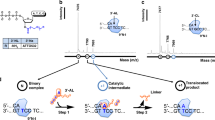Abstract
Nucleotidyl-transfer enzymes, which synthesize, degrade and rearrange DNA and RNA, often depend on metal ions for catalysis. All DNA and RNA polymerases, MutH-like or RNase H–like nucleases and recombinases, and group I introns seem to require two divalent cations to form a complete active site. The two-metal-ion mechanism has been proposed to orient the substrate, facilitate acid-base catalysis and allow catalytic specificity to exceed substrate binding specificity attributable to the stringent metal-ion (Mg2+ in particular) coordination. Not all nucleotidyl-transfer enzymes use two metal ions for catalysis, however. The ββα-Me and HUH nucleases depend on a single metal ion in the active site for the catalysis. All of these one- and two metal ion–dependent enzymes generate 5′-phosphate and 3′-OH products. Structural and mechanistic comparisons show that these seemingly unrelated nucleotidyl-transferases share a functionally equivalent metal ion.
This is a preview of subscription content, access via your institution
Access options
Subscribe to this journal
Receive 12 print issues and online access
$189.00 per year
only $15.75 per issue
Buy this article
- Purchase on Springer Link
- Instant access to full article PDF
Prices may be subject to local taxes which are calculated during checkout



Similar content being viewed by others
References
Pelletier, H., Sawaya, M.R., Kumar, A., Wilson, S.H. & Kraut, J. Structures of ternary complexes of rat DNA polymerase β, a DNA template-primer, and ddCTP. Science 264, 1891–1903 (1994).
Doublie, S., Tabor, S., Long, A.M., Richardson, C.C. & Ellenberger, T. Crystal structure of a bacteriophage T7 DNA replication complex at 2.2 Å resolution. Nature 391, 251–258 (1998).
Steitz, T.A. A mechanism for all polymerases. Nature 391, 231–232 (1998).
Beese, L.S. & Steitz, T.A. Structural basis for the 3′-5′ exonuclease activity of Escherichia coli DNA polymerase I: a two metal ion mechanism. EMBO J. 10, 25–33 (1991).
Lee, J.Y. et al. MutH complexed with hemi- and unmethylated DNAs: coupling base recognition and DNA cleavage. Mol. Cell 20, 155–166 (2005).
Nowotny, M. & Yang, W. Stepwise analyses of metal ions in RNase H catalysis from substrate destabilization to product release. EMBO J. 25, 1924–1933 (2006).
Stahley, M.R. & Strobel, S.A. RNA splicing: group I intron crystal structures reveal the basis of splice site selection and metal ion catalysis. Curr. Opin. Struct. Biol. 16, 319–326 (2006).
Yang, W., Lee, J.Y. & Nowotny, M. Making and breaking nucleic acids: two-Mg2+-ion catalysis and substrate specificity. Mol. Cell 22, 5–13 (2006).
Sowadski, J.M., Handschumacher, M.D., Murthy, H.M., Foster, B.A. & Wyckoff, H.W. Refined structure of alkaline phosphatase from Escherichia coli at 2.8 Å resolution. J. Mol. Biol. 186, 417–433 (1985).
Freemont, P.S., Friedman, J.M., Beese, L.S., Sanderson, M.R. & Steitz, T.A. Cocrystal structure of an editing complex of Klenow fragment with DNA. Proc. Natl. Acad. Sci. USA 85, 8924–8928 (1988).
Steitz, T.A. & Steitz, J.A. A general two-metal-ion mechanism for catalytic RNA. Proc. Natl. Acad. Sci. USA 90, 6498–6502 (1993).
Batra, V.K. et al. Magnesium-induced assembly of a complete DNA polymerase catalytic complex. Structure 14, 757–766 (2006).
Brautigam, C.A., Sun, S., Piccirilli, J.A. & Steitz, T.A. Structures of normal single-stranded DNA and deoxyribo-3′-S-phosphorothiolates bound to the 3′-5′ exonucleolytic active site of DNA polymerase I from Escherichia coli. Biochemistry 38, 696–704 (1999).
Viadiu, H. & Aggarwal, A.K. Structure of BamHI bound to nonspecific DNA: a model for DNA sliding. Mol. Cell 5, 889–895 (2000).
Horton, N.C. & Perona, J.J. DNA cleavage by EcoRV endonuclease: two metal ions in three metal ion binding sites. Biochemistry 43, 6841–6857 (2004).
Nowotny, M. et al. Structure of human RNase H1 complexed with an RNA/DNA hybrid: insight into HIV reverse transcription. Mol. Cell 28, 264–276 (2007).
Friedhoff, P. et al. A similar active site for non-specific and specific endonucleases. Nat. Struct. Biol. 6, 112–113 (1999).
Kuhlmann, U.C., Moore, G.R., James, R., Kleanthous, C. & Hemmings, A.M. Structural parsimony in endonuclease active sites: should the number of homing endonuclease families be redefined? FEBS Lett. 463, 1–2 (1999).
Hsia, K.C., Li, C.L. & Yuan, H.S. Structural and functional insight into sugar-nonspecific nucleases in host defense. Curr. Opin. Struct. Biol. 15, 126–134 (2005).
Stoddard, B.L. Homing endonuclease structure and function. Q. Rev. Biophys. 38, 49–95 (2005).
Biertümpfel, C., Yang, W. & Suck, D. Crystal structure of T4 endonuclease VII resolving a Holliday junction. Nature 449, 616–620 (2007).
Meiss, G., Gimadutdinow, O., Friedhoff, P. & Pingoud, A.M. Microtiter-plate assay and related assays for nonspecific endonucleases. Methods Mol. Biol. 160, 37–48 (2001).
Woo, E.J. et al. Structural mechanism for inactivation and activation of CAD/DFF40 in the apoptotic pathway. Mol. Cell 14, 531–539 (2004).
Mehta, P., Katta, K. & Krishnaswamy, S. HNH family subclassification leads to identification of commonality in the His-Me endonuclease superfamily. Protein Sci. 13, 295–300 (2004).
Ton-Hoang, B. et al. Transposition of ISHp608, member of an unusual family of bacterial insertion sequences. EMBO J. 24, 3325–3338 (2005).
Barabas, O. et al. Mechanism of IS200/IS605 family DNA transposases: activation and transposon-directed target site selection. Cell 132, 208–220 (2008).
Koonin, E.V. & Ilyina, T.V. Computer-assisted dissection of rolling circle DNA replication. Biosystems 30, 241–268 (1993).
Guasch, A. et al. Recognition and processing of the origin of transfer DNA by conjugative relaxase TrwC. Nat. Struct. Biol. 10, 1002–1010 (2003).
Datta, S., Larkin, C. & Schildbach, J.F. Structural insights into single-stranded DNA binding and cleavage by F factor TraI. Structure 11, 1369–1379 (2003).
Monzingo, A.F., Ozburn, A., Xia, S., Meyer, R.J. & Robertus, J.D. The structure of the minimal relaxase domain of MobA at 2.1 Å resolution. J. Mol. Biol. 366, 165–178 (2007).
Hickman, A.B., Ronning, D.R., Kotin, R.M. & Dyda, F. Structural unity among viral origin binding proteins: crystal structure of the nuclease domain of adeno-associated virus Rep. Mol. Cell 10, 327–337 (2002).
Campos-Olivas, R., Louis, J.M., Clerot, D., Gronenborn, B. & Gronenborn, A.M. The structure of a replication initiator unites diverse aspects of nucleic acid metabolism. Proc. Natl. Acad. Sci. USA 99, 10310–10315 (2002).
Dyda, F. & Hickman, A.B. A mob of Reps. Structure 11, 1310–1311 (2003).
Gomis-Ruth, F.X. & Coll, M. Cut and move: protein machinery for DNA processing in bacterial conjugation. Curr. Opin. Struct. Biol. 16, 744–752 (2006).
Larkin, C. et al. Inter- and intramolecular determinants of the specificity of single-stranded DNA binding and cleavage by the F factor relaxase. Structure 13, 1533–1544 (2005).
Boer, R. et al. Unveiling the molecular mechanism of a conjugative relaxase: the structure of TrwC complexed with a 27-mer DNA comprising the recognition hairpin and the cleavage site. J. Mol. Biol. 358, 857–869 (2006).
Nowotny, M., Gaidamakov, S.A., Crouch, R.J. & Yang, W. Crystal structures of RNase H bound to an RNA/DNA hybrid: substrate specificity and metal-dependent catalysis. Cell 121, 1005–1016 (2005).
Larkin, C., Haft, R.J., Harley, M.J., Traxler, B. & Schildbach, J.F. Roles of active site residues and the HUH motif of the F plasmid TraI relaxase. J. Biol. Chem. 282, 33707–33713 (2007).
Maguire, M.E. & Cowan, J.A. Magnesium chemistry and biochemistry. Biometals 15, 203–210 (2002).
Mate, M.J. & Kleanthous, C. Structure-based analysis of the metal-dependent mechanism of H-N-H endonucleases. J. Biol. Chem. 279, 34763–34769 (2004).
Hsia, K.C. et al. DNA binding and degradation by the HNH protein ColE7. Structure 12, 205–214 (2004).
Doudeva, L.G. et al. Crystal structural analysis and metal-dependent stability and activity studies of the ColE7 endonuclease domain in complex with DNA/Zn2+ or inhibitor/Ni2+. Protein Sci. 15, 269–280 (2006).
Galburt, E.A. et al. A novel endonuclease mechanism directly visualized for I-PpoI. Nat. Struct. Biol. 6, 1096–1099 (1999).
Li, C.L. et al. DNA binding and cleavage by the periplasmic nuclease Vvn: a novel structure with a known active site. EMBO J. 22, 4014–4025 (2003).
Shen, B.W., Landthaler, M., Shub, D.A. & Stoddard, B.L. DNA binding and cleavage by the HNH homing endonuclease I-HmuI. J. Mol. Biol. 342, 43–56 (2004).
Raaijmakers, H. et al. X-ray structure of T4 endonuclease VII: a DNA junction resolvase with a novel fold and unusual domain-swapped dimer architecture. EMBO J. 18, 1447–1458 (1999).
Harding, M.M. The geometry of metal-ligand interactions relevant to proteins. Acta Crystallogr. D Biol. Crystallogr. 55, 1432–1443 (1999).
Harding, M.M. The architecture of metal coordination groups in proteins. Acta Crystallogr. D Biol. Crystallogr. 60, 849–859 (2004).
Derbyshire, V., Grindley, N.D. & Joyce, C.M. The 3′-5′ exonuclease of DNA polymerase I of Escherichia coli: contribution of each amino acid at the active site to the reaction. EMBO J. 10, 17–24 (1991).
Jones, T.A., Zou, J.-Y. & Cowan, S.W. Improved methods for building models in electron density maps and the location of errors in these models. Acta Crystallogr. A 47, 110–119 (1991).
Acknowledgements
I thank C. Biertümpfel, C. Larkin and M. Nowotny for stimulating discussion, and B. Craigie, F. Dyda, D. Leahy and H. Yuan for critical reading of the manuscript. This research was supported by the Intramural Research Program of the US National Institute of Diabetes and Digestive and Kidney Diseases, National Institutes of Health.
Author information
Authors and Affiliations
Corresponding author
Rights and permissions
About this article
Cite this article
Yang, W. An equivalent metal ion in one- and two-metal-ion catalysis. Nat Struct Mol Biol 15, 1228–1231 (2008). https://doi.org/10.1038/nsmb.1502
Received:
Accepted:
Published:
Issue Date:
DOI: https://doi.org/10.1038/nsmb.1502
This article is cited by
-
The development of genome editing tools as powerful techniques with versatile applications in biotechnology and medicine: CRISPR/Cas9, ZnF and TALE nucleases, RNA interference, and Cre/loxP
ChemTexts (2021)
-
Structure and Dynamics of Cas9 HNH Domain Catalytic State
Scientific Reports (2017)
-
Cas9-catalyzed DNA Cleavage Generates Staggered Ends: Evidence from Molecular Dynamics Simulations
Scientific Reports (2016)
-
The CRISPR-associated DNA-cleaving enzyme Cpf1 also processes precursor CRISPR RNA
Nature (2016)
-
Role of monovalent and divalent metal cations in human ribokinase catalysis and regulation
BioMetals (2015)



